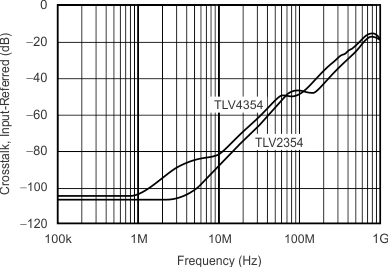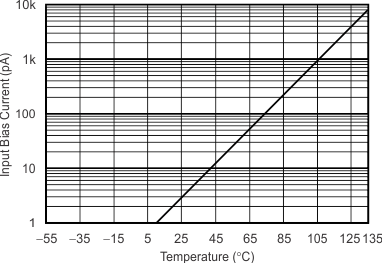SBOS756 October 2016 TLV3541 , TLV3542 , TLV3544
PRODUCTION DATA.
- 1 Features
- 2 Applications
- 3 Description
- 4 Revision History
- 5 Pin Configuration and Functions
- 6 Specifications
- 7 Detailed Description
- 8 Application and Implementation
- 9 Power Supply Recommendations
- 10Layout
- 11Device and Documentation Support
- 12Mechanical, Packaging, and Orderable Information
Package Options
Mechanical Data (Package|Pins)
Thermal pad, mechanical data (Package|Pins)
Orderable Information
6 Specifications
6.1 Absolute Maximum Ratings
over operating free-air temperature range (unless otherwise noted)(1)| MIN | MAX | UNIT | ||
|---|---|---|---|---|
| Voltage | Supply voltage, V+ to V− | 7.5 | V | |
| Signal input terminals(2) | (V–) – (0.5) | (V+) + 0.5 | V | |
| Current | Signal input terminals(2) | –10 | 10 | mA |
| Output short circuit(3) | Continuous | |||
| Temperature | Operating, TA | –55 | 150 | °C |
| Junction, TJ | –65 | 150 | °C | |
| Storage, Tstg | 150 | °C | ||
(1) Stresses beyond those listed under Absolute Maximum Ratings may cause permanent damage to the device. These are stress ratings only, which do not imply functional operation of the device at these or any other conditions beyond those indicated under Recommended Operating Conditions. Exposure to absolute-maximum-rated conditions for extended periods may affect device reliability.
(2) Input pins are diode-clamped to the power-supply rails. Input signals that can swing more than 0.5 V beyond the supply rails must be current limited to 10 mA or less.
(3) Short-circuit to ground, one amplifier per package.
6.2 ESD Ratings
| VALUE | UNIT | |||
|---|---|---|---|---|
| V(ESD) | Electrostatic discharge | Human-body model (HBM), per ANSI/ESDA/JEDEC JS-001(1) | 1000 | V |
| Charged-device model (CDM), per JEDEC specification JESD22-C101(2) | 250 | |||
(1) JEDEC document JEP155 states that 500-V HBM allows safe manufacturing with a standard ESD control process.
(2) JEDEC document JEP157 states that 250-V CDM allows safe manufacturing with a standard ESD control process.
6.3 Recommended Operating Conditions
over operating free-air temperature range (unless otherwise noted)| MIN | NOM | MAX | UNIT | ||
|---|---|---|---|---|---|
| VS | Supply voltage, V– to V+ | 2.5 | 5.5 | V | |
| Specified temperature range | –40 | 125 | °C | ||
6.4 Thermal Information: TLV3541
| THERMAL METRIC(1) | TLV3541 | UNIT | ||
|---|---|---|---|---|
| D (SOIC) | DBV (SOT-23) | |||
| 8 PINS | 5 PINS | |||
| RθJA | Junction-to-ambient thermal resistance | 123.8 | 216.3 | °C/W |
| RθJC(top) | Junction-to-case (top) thermal resistance | 68.7 | 84.3 | °C/W |
| RθJB | Junction-to-board thermal resistance | 64.5 | 43.1 | °C/W |
| ψJT | Junction-to-top characterization parameter | 23.0 | 3.8 | °C/W |
| ψJB | Junction-to-board characterization parameter | 64.0 | 42.3 | °C/W |
| RθJC(bot) | Junction-to-case (bottom) thermal resistance | N/A | N/A | °C/W |
(1) For more information about traditional and new thermal metrics, see Semiconductor and IC Package Thermal Metrics (SPRA953).
6.5 Thermal Information: TLV3542
| THERMAL METRIC(1) | TLV3542 | UNIT | ||
|---|---|---|---|---|
| D (SOIC) | DGK (VSSOP) | |||
| 8 PINS | 8 PINS | |||
| RθJA | Junction-to-ambient thermal resistance | 113.9 | 175.9 | °C/W |
| RθJC(top) | Junction-to-case (top) thermal resistance | 60.4 | 67.8 | °C/W |
| RθJB | Junction-to-board thermal resistance | 54.1 | 97.1 | °C/W |
| ψJT | Junction-to-top characterization parameter | 17.1 | 9.3 | °C/W |
| ψJB | Junction-to-board characterization parameter | 53.6 | 95.5 | °C/W |
| RθJC(bot) | Junction-to-case (bottom) thermal resistance | N/A | N/A | °C/W |
(1) For more information about traditional and new thermal metrics, see Semiconductor and IC Package Thermal Metrics (SPRA953).
6.6 Thermal Information: TLV3544
| THERMAL METRIC(1) | TLV3544 | UNIT | ||
|---|---|---|---|---|
| D (SOIC) | PW (TSSOP) | |||
| 14 PINS | 14 PINS | |||
| RθJA | Junction-to-ambient thermal resistance | 83.8 | 92.6 | °C/W |
| RθJC(top) | Junction-to-case (top) thermal resistance | 70.7 | 27.5 | °C/W |
| RθJB | Junction-to-board thermal resistance | 59.5 | 33.6 | °C/W |
| ψJT | Junction-to-top characterization parameter | 11.6 | 1.9 | °C/W |
| ψJB | Junction-to-board characterization parameter | 37.7 | 33.1 | °C/W |
| RθJC(bot) | Junction-to-case (bottom) thermal resistance | N/A | N/A | °C/W |
(1) For more information about traditional and new thermal metrics, see Semiconductor and IC Package Thermal Metrics (SPRA953).
6.7 Electrical Characteristics: VS = 2.7 V to 5.5 V Single-Supply
at TA = 25°C, RF = 0 Ω, RL = 1 kΩ, and connected to VS / 2 (unless otherwise noted)| PARAMETER | TEST CONDITIONS | MIN | TYP | MAX | UNIT | ||
|---|---|---|---|---|---|---|---|
| OFFSET VOLTAGE | |||||||
| VOS | Input offset voltage | VS = 5 V, at TA = 25°C | ±2 | ±10 | mV | ||
| dVOS/dT | Input offset voltage vs temperature | VS = 5 V, at TA = −40°C to +125°C | ±4.5 | μV/°C | |||
| PSRR | Input offset voltage vs power supply | VS = 2.7 V to 5.5 V, VCM = (VS / 2) − 0.55 V |
60 | 70 | dB | ||
| INPUT BIAS CURRENT | |||||||
| IB | Input bias current | 3 | pA | ||||
| IOS | Input offset current | ±1 | pA | ||||
| NOISE | |||||||
| en | Input voltage noise density | f = 1 MHz | 7.5 | nV/√Hz | |||
| in | Current noise density | f = 1 MHz | 50 | fA/√Hz | |||
| INPUT VOLTAGE RANGE | |||||||
| VCM | Common-mode voltage range | (V−) − 0.1 | (V+) + 0.1 | V | |||
| CMRR | Common-mode rejection ratio | VS = 5.5 V, –0.1 V < VCM < 3.5 V, at TA = 25°C |
66 | 80 | dB | ||
| VS = 5.5 V, –0.1 V < VCM < 5.6 V, at TA = 25°C |
56 | 68 | dB | ||||
| INPUT IMPEDANCE | |||||||
| Differential | 1013 || 2 | Ω || pF | |||||
| Common-mode | 1013 || 2 | Ω || pF | |||||
| OPEN-LOOP GAIN | |||||||
| AOL | Open-loop gain | VS = 5 V, 0.3 V < VO < 4.7 V, at TA = 25°C |
92 | 108 | dB | ||
| FREQUENCY RESPONSE | |||||||
| f−3dB | Small-signal bandwidth | At G = +1, VO = 10 mV RF = 25 Ω |
200 | MHz | |||
| At G = +2, VO = 10 mV | 90 | MHz | |||||
| GBW | Gain-bandwidth product | G = +10 | 100 | MHz | |||
| f0.1dB | Bandwidth for 0.1-dB gain flatness | At G = +2, VO = 10 mV | 40 | MHz | |||
| SR | Slew rate | VS = 5 V, G = +1, 4-V step | 150 | V / μs | |||
| VS = 5 V, G = +1, 2-V step | 130 | V / μs | |||||
| Rise-and-fall time | At G = +1, VO = 200 mVPP, 10% to 90% |
2 | ns | ||||
| At G = +1, VO = 2 VPP, 10% to 90% | 11 | ns | |||||
| Settling time | 0.1%, VS = 5 V, G = +1, 2-V output step |
30 | ns | ||||
| 0.01%, VS = 5 V, G = +1, 2-V output step |
60 | ns | |||||
| Overload recovery time | VIN × Gain = VS | 5 | ns | ||||
| FREQUENCY RESPONSE, continued | |||||||
| Harmonic distortion | Second harmonic | At G = +1, f = 1 MHz, VO = 2 VPP, RL = 200 Ω, VCM = 1.5 V |
–75 | dBc | |||
| Third harmonic | At G = +1, f = 1 MHz, VO = 2 VPP, RL = 200 Ω, VCM = 1.5 V |
–83 | dBc | ||||
| Differential gain error | NTSC, RL = 150 Ω | 0.02% | |||||
| Differential phase error | NTSC, RL = 150 Ω | 0.09 | ° | ||||
| Channel-to-channel crosstalk | TLV3542 | f = 5 MHz | –100 | dB | |||
| TLV3544 | –84 | dB | |||||
| OUTPUT | |||||||
| Voltage output swing from rail | VS = 5 V, RL = 1 kΩ at TA = 25°C | 0.1 | 0.3 | V | |||
| IO | Output current, single, dual, quad(1)(2) | VS = 5 V | 100 | mA | |||
| VS = 3 V | 50 | mA | |||||
| Closed-loop output impedance | f < 100 kHz | 0.05 | Ω | ||||
| RO | Open-loop output resistance | 35 | Ω | ||||
| POWER SUPPLY | |||||||
| VS | Specified voltage range | 2.7 | 5.5 | V | |||
| Operating voltage range | 2.5 | 5.5 | V | ||||
| IQ | Quiescent current (per amplifier) | At TA = 25°C, VS = 5 V, IO = 0 |
5.2 | 6.5 | mA | ||
| TEMPERATURE RANGE | |||||||
| Specified range | –40 | 125 | °C | ||||
| Operating range (3) | –55 | 150 | °C | ||||
| Storage range | –65 | 150 | °C | ||||
| THERMAL SHUTDOWN | |||||||
| Shutdown temperature | 160 | °C | |||||
| Reset from shutdown | 140 | °C | |||||
(1) See typical characteristic curves, Output Voltage Swing vs Output Current (Figure 14 and Figure 15).
(2) Specified by design.
(3) Operating in this temperature range will not damage the part. However, degraded performance may be observed.
6.8 Typical Characteristics
at TA = 25°C, VS = 5 V, G = +1, RF = 0 Ω, RL = 1 kΩ, and connected to VS / 2, unless otherwise noted.
| RF = 604 Ω | VO = 10 mVpp |


| G = +1, RF = 0 Ω | VO = 10 mVpp | CL = 0 pF |




for VS = 3 V






| G = +1, RS = 0 Ω | VO = 10 mVpp |

| G = +1, VO = 10 mVpp | ||



for VS = 5 V

